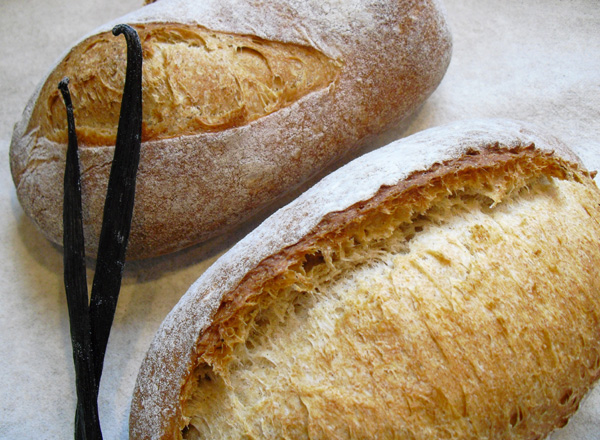inlovewbread's blog
More San Joaquin Sourdough and fermentation Questions
I made up another batch of dmsnyder's San Joaquin Sourdough and this is my bake. They are still singing as I type this! I got a better ear this time- I think it was a better scoring, I cut a little deeper than the last try. Also, I used the full 21 hour cold fermentation for this bake as apposed to the 14 hours on the last attempt. I don't know if this has anything to do with the better ear or not.
My question though is (I guess directed at David, but others please chime in):
Things are looking up!- Sourdoughs
My last few bakes haven't been so successful. Formulae that usually turned out well were coming out of the oven looking sad. I can't figure out if I was over or under-proofing. I kept trying at it to get the timing right on Glezer's Colombia. Incidentally I posted about it on my blog because it's the family's favorite bread, but lately the scoring just doesn't open up. The flavor is great, but I can't get it to look the way I want it to anymore! Ugh! Then I made a few other breads that just turned out so-so. How is it that my bread could be getting worse?
Pain au Levain a la Vanille

Pain au Levain a la Vanille ( sourdough bread with vanilla )
I recently was gifted some beautiful organic vanilla beans. They have been calling to me from my pantry for a few weeks now. I wanted to incorporate them into some sort of bread but couldn't think of something that would pair well with the vanilla bean and still be good in a bread. I decided to let the smell and taste of vanilla to shine through and just use it on its own.
Essential's Columbia
This bread is from Maggie Glezer's gem of a book: Artisan Baking. I have been wanting to make this bread for a while because it was named after the Columbia River. As a Washington State native, I had to make it. I'm glad I did as this bread has become my new personal favorite.
Formula:
Potato Leek Bread
This is Potato Leek bread from SteveB's "Bread cetera" blog. His breads are amazing, and this one is no exception. The potato and leek go so well together. I used Yukon Gold potatoes instead of the red potatoes called for in the formula. I've made it both ways though and both are good (I think). The only other change I made was to use my firm starter in lieu of the 100% hydration starter.
Second and Third Ryes
The first rye that I made can be found here. It was a 80% Rye with a Rye Flour Soaker from Hamelman's Bread. I have to add to my previous post, that the flavor developed over the next few days and the crust softened up. I liked the bread a lot and it was good with just a little butter on it :-) At first I wasn't that impressed but as time went on I came to really like it. I saved the last third or so of the loaf for use as altus.
First Rye
I've been baking my way through Hamelman's "Bread". Sometimes I don't always go in order- and right now, I'm stuck on the Sourdough Rye section. I decided to go with the "80% Rye with a Rye-Flour Soaker" (page 213) instead of starting with the first (40%) rye of the chapter. I deviated from the formula a bit as I baked a single pullman loaf instead of the 2 free-form loaves specified. I'm not afraid to shape rye- actually, I'm looking forward to seeing what it's like...but I do like the look of a pullman loaf. Same way I'm attracted to Volvo's, Frank Lloyd Wright architecture and cubism.
Mixed Flour SD Boule
I'm calling this "Mixed Flour" because I used a lot of different flours. I wanted to see if I could get the characteristics I wanted in the crumb by adjusting just the flours. It seemed to have worked, so here's what I used:
Again (It's a family/personal favorite :-)), I was following Susan's Simple Sourdough formula. Only hers doesn't call for so many flours!
50g Firm Starter (mine is 50% hydration composed of 10% rye and 90% AP)
205g Water
